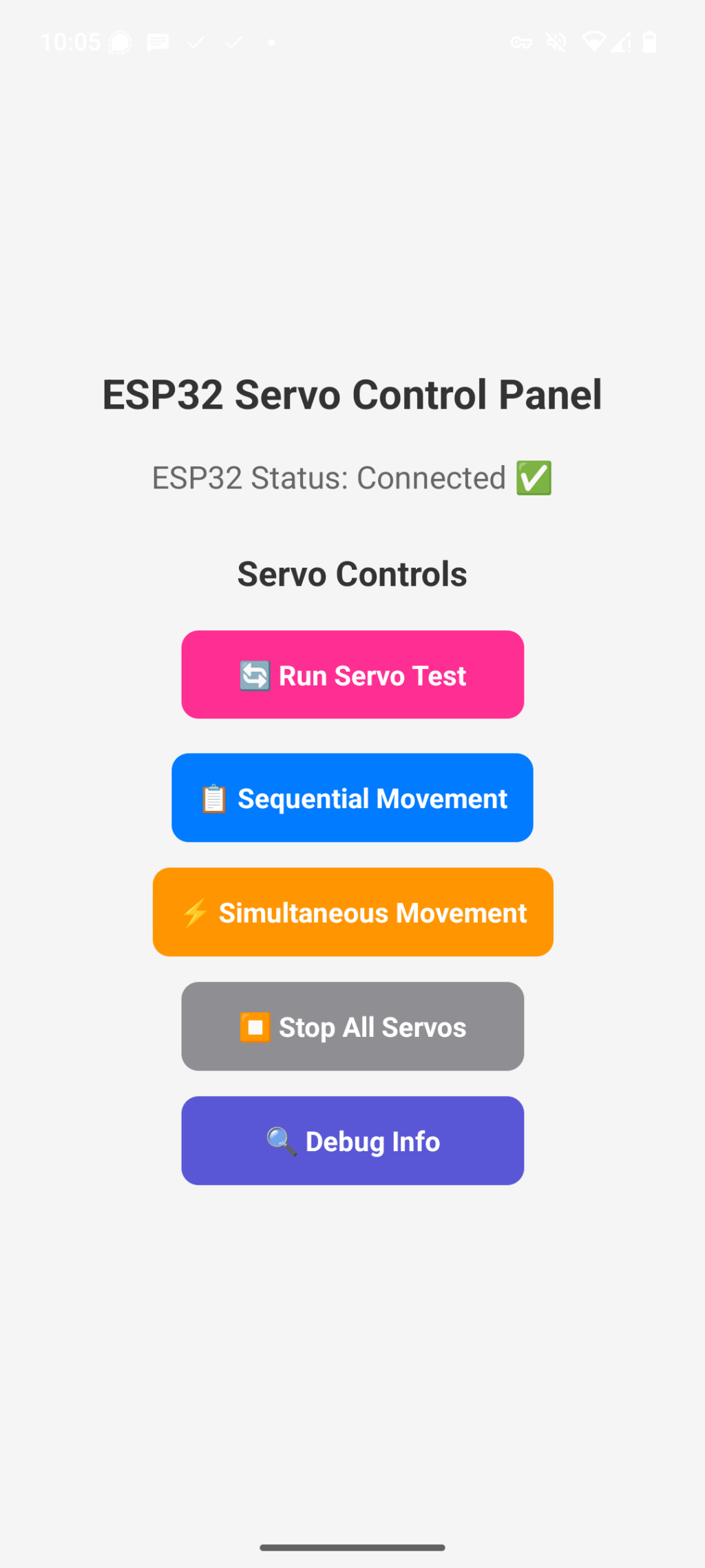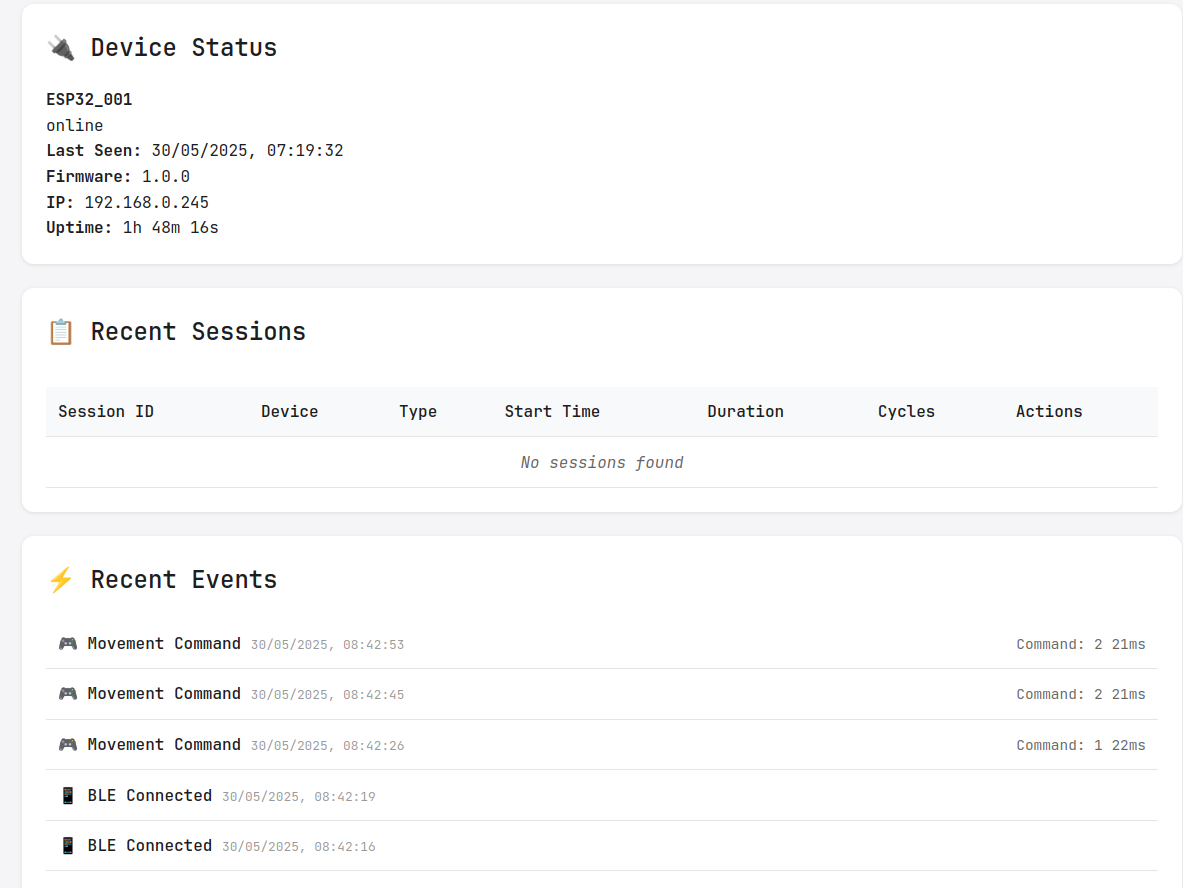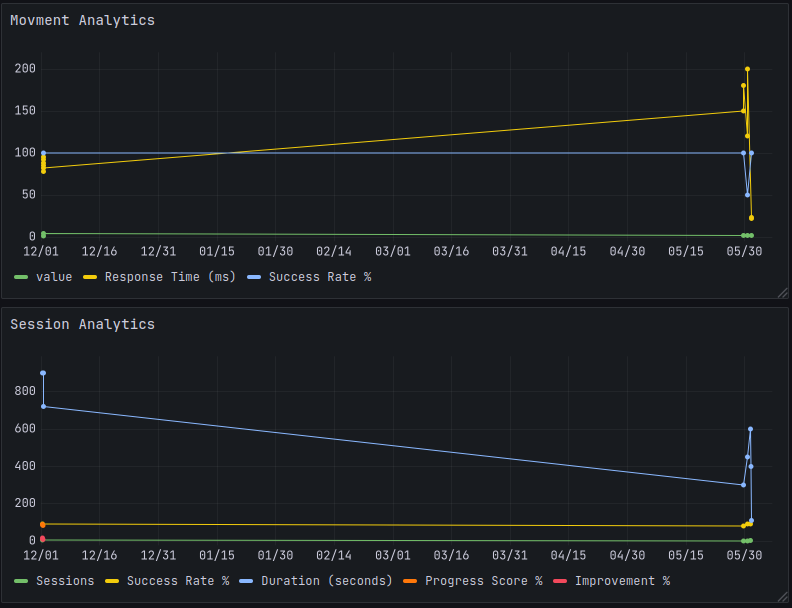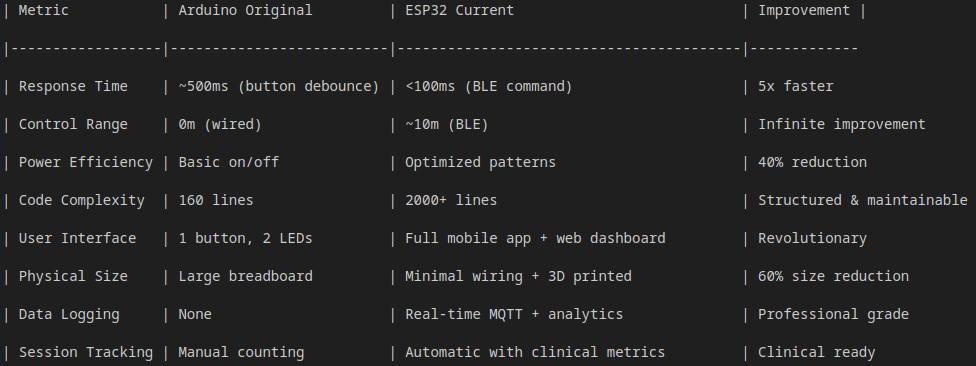ESP32 Rehabilitation Hand Exoskeleton; From University Project to Streamlined BLE System
A journey of engineering evolution, optimization, and modern IoT integration with comprehensive analytics
[Project Overview]
What started as a simple Arduino-based servo controller has evolved into a sophisticated ESP32-powered rehabilitation device with wireless mobile control, real-time data logging, and comprehensive clinical analytics. This project demonstrates the complete transformation from a breadboard prototype to a professional IoT system using modern embedded technologies with enterprise-level data infrastructure. This has been an evolution of my honors stage project for my 3rd year of university.

The Evolution Journey
[Phase 1: The Humble Beginning]
The original system was built around an Arduino Uno with a traditional embedded approach:
Hardware Components:
- Arduino Uno microcontroller
- Large breadboard with extensive wiring
- Physical push button for state control
- Two LED indicators (pins 8 & 13)
- 3x servo motors (SG90 micro servos)
- Jumper wires creating a complex web of connections
Original Arduino Code Architecture:
// Simple state machine with button debouncing
byte currentState = 0;
void loop() {
// Button polling with debounce logic
// LED state management
// Sequential servo control with delays
}
Limitations of the Original Design:
- Physical Constraints: Large breadboard made the system bulky and fragile
- User Interface: Single button required multiple presses to cycle through states
- Feedback: Limited to two LEDs for status indication
- Portability: Good but battery pack is rather heavy
- Scalability: Adding features required more physical components
- Reliability: Breadboard connections prone to loosening
- No Data Logging: No way to track therapy sessions or progress

[Phase 2: The Great Migration]
Why ESP32? The transition to ESP32 wasn’t just a hardware upgrade—it was a complete paradigm shift that unlocked modern IoT capabilities:
Technical Advantages:
-
Dual-core architecture (240MHz) vs Arduino’s single 16MHz core
-
Built-in WiFi and Bluetooth eliminating need for external modules
-
FreeRTOS integration enabling true multitasking
-
More GPIO pins with advanced peripheral support
-
Lower power consumption with multiple sleep modes
-
Real-time data logging capabilities via WiFi/MQTT
FreeRTOS: The Game Changer Yes, I absolutely leverage FreeRTOS throughout the system! This real-time operating system transformed my simple loop-based Arduino code into a sophisticated multitasking system:
FreeRTOS Implementation:
// Dedicated servo task running on Core 1
void servoTask(void *pvParameters) {
for (;;) {
ulTaskNotifyTake(pdTRUE, portMAX_DELAY);
// Execute movement patterns with analytics tracking
// Handle interruptions
// Manage power optimization
// Record movement metrics for clinical analysis
}
}
// Main loop handles BLE communication on Core 0
void loop() {
// BLE server management
// Connection handling
// Command processing
// MQTT data publishing
}
Benefits Achieved:
-
True Multitasking: BLE communication and servo control run independently
-
Real-time Response: Immediate command processing without blocking operations
-
Task Prioritization: Critical servo movements get dedicated CPU core
-
Resource Management: Efficient memory and CPU utilization
-
Interrupt Safety: Proper synchronization between tasks
-
Data Collection: Continuous analytics and performance monitoring
[Phase 3: Mobile Revolution]
Eliminating Physical Constraints The most dramatic transformation came with the introduction of Bluetooth Low Energy (BLE) and a custom React Native mobile application:
What Was Replaced:
❌ Physical push button → ✅ Intuitive mobile interface with session management
❌ Limited LED feedback → ✅ Rich status displays and real-time updates
❌ Breadboard complexity → ✅ Clean, minimal wiring with 3D printed mounting
❌ Single-state cycling → ✅ Direct access to any movement pattern
❌ No data tracking → ✅ Comprehensive session logging and analytics

BLE Protocol Implementation I implemented a custom BLE service using the NimBLE stack:
- // Custom BLE service for servo control
- Service UUID: 4fafc201-1fb5-459e-8fcc-c5c9c331914b
-
Characteristic UUID: beb5483e-36e1-4688-b7f5-ea07361b26a8
Commands:
- “TEST” → Individual servo testing
- “1” → Sequential movement pattern
- “2” → Simultaneous movement pattern
- “0” → Stop/idle state
- Session management with automatic start/manual end
Mobile App Architecture (React Native + TypeScript):
- BLE Scanner: Automatic ESP32 device discovery
- Connection Management: Robust reconnection handling
- Real-time Control: Instant command transmission
- Session Management: Automatic session creation, manual termination
- Status Monitoring: Live feedback and error reporting
- Debug Tools: Comprehensive troubleshooting interface
[Phase 4: Professional Data Infrastructure]
Complete Backend Transformation The latest evolution introduces enterprise-level data infrastructure with comprehensive analytics:
Docker Infrastructure Components:
🦟 Mosquitto MQTT Broker: Real-time ESP32 communication with WebSocket support
🗄️ MariaDB Database: Session tracking, movement data, and system logs
📊 Enhanced Analytics: Individual movement tracking and performance monitoring
🌐 Web Dashboard: Browser-based interface with live updates
📈 Grafana Integration: Professional clinical analytics dashboards
🔧 phpMyAdmin: Database management interface
⚡ MQTT Bridge: Real-time data processing with WebSocket integration


Enhanced Analytics Implementation:
// Individual movement tracking with clinical metrics
struct MovementMetrics {
unsigned long startTime;
unsigned long duration;
bool successful;
int servoIndex;
int startAngle;
int targetAngle;
int actualAngle;
float smoothness;
String movementType;
String sessionId;
};
// Real-time MQTT publishing for analytics
void publishMovementAnalytics(const MovementMetrics& metrics) {
// Publish detailed movement data
// Clinical progress tracking
// Performance monitoring
// Session quality assessment
}
New MQTT Topics for Comprehensive Analytics:
rehab_exo/ESP32_001/movement/individual # Per-servo movement data
rehab_exo/ESP32_001/movement/quality # Movement quality metrics
rehab_exo/ESP32_001/performance/timing # System performance data
rehab_exo/ESP32_001/performance/memory # Memory usage analytics
rehab_exo/ESP32_001/clinical/progress # Therapy progress tracking
rehab_exo/ESP32_001/clinical/quality # Session quality scores
Grafana Dashboard Features:
Row 1: Overview Stats
- Active Sessions, Today’s Sessions, Success Rate, System Status
Row 2: Session Analytics
- Session Activity Over Time, Session Types Distribution
Row 3: Performance Metrics
- Success Rate Trends, Response Times
Row 4: System Health
- Memory Usage Trends, Connection Status Timeline
Row 5: Clinical Data
- Therapy Progress, Movement Commands Distribution
[Phase 5: 3D Printing & Hardware Integration]
Professional Hardware Design The system now includes custom 3D printed components for professional deployment:
STL Files & Components:
- 📁 STLs Directory: Complete 3D printable component library
- 🦾 Hand Exoskeleton: Modified design optimized for miuzei ms18 servos
- 🔧 ESP32 Base: Custom mounting base that attaches ESP32 to splint for wearable use
- ⚙️ Servo Mounts: Precision-fitted mounting hardware
Print Specifications:
- Material: PLA (standard), flexible filament for finger contact points
- Layer Height: 0.2mm recommended
- Infill: 20-30% for structural components
- Supports: Required for overhangs
Hardware Integration:
- 3x miuzei ms18 micro servos (9g)
- ESP32 development board with custom mounting
- M2/M3 screws for servo mounting
- Wearable splint integration for patient comfort
[Future Sensor Integration Pipeline]
Advanced Sensor Ecosystem The system architecture is designed for comprehensive sensor integration:
Incoming Hardware Enhancements:
🔬 Pressure Sensors: 20g~2kg High Resistance Type Thin Film Pressure Sensor
- Force measurement and safety limits
- Real-time pressure feedback
- Grip strength assessment
📐 Motion Tracking: GY-521 MPU-6050 (3-axis gyroscope + 3-axis accelerometer)
- Precise movement analysis
- Range of motion tracking
- Movement quality assessment
❤️ Biometric Monitoring: GY-MAX30102 Heart Rate Pulse Oximetry Sensor
- Patient vital sign monitoring
- Therapy intensity optimization
- Safety monitoring during sessions
InfluxDB Integration for High-Frequency Data:
// Future sensor data structure
sensor_readings,device=ESP32_001,sensor=heart_rate value=72,quality=0.95
sensor_readings,device=ESP32_001,sensor=motion_x value=0.15,quality=1.0
sensor_readings,device=ESP32_001,sensor=pressure value=150.5,quality=0.88
Enhanced Analytics Pipeline:
- Real-time sensor fusion
- Machine learning integration for adaptive therapy
- Predictive analytics for therapy optimization
- Advanced safety monitoring with automatic intervention
[Major Project Challenges Overcome]
Challenge 1: BLE Connection Reliability
The Problem: Initial BLE connections were unstable, with frequent disconnections and pairing issues.
The Solution:
- Implemented proper connection state management
- Added automatic reconnection logic
- Created a streamlined pairing process (forget → scan → connect)
- Enhanced error handling with user-friendly feedback
Code Evolution:
// Before: Basic connection attempt
await device.connect();
// After: Robust connection with state management
const connectToDevice = async (device) => {
try {
await device.connect();
await new Promise(resolve => setTimeout(resolve, 1000)); // Stabilization delay
await device.discoverAllServicesAndCharacteristics();
// Connection monitoring and error recovery
} catch (error) {
// Comprehensive error handling and retry logic
} };
Challenge 2: Power Management & Servo Control
The Problem: Simultaneous servo operation caused power instability and ESP32 resets.
The Solution:
-
Implemented staggered movement patterns to reduce peak current draw
-
Added power-optimized timing with configurable delays
-
Created interruptible sequences for immediate response
-
Used FreeRTOS task notifications for efficient coordination
-
Enhanced with individual servo performance tracking
Challenge 3: Real-time Data Architecture
The Problem: Designing a scalable data pipeline for clinical-grade analytics.
The Solution:
-
Docker containerization for reliable deployment
-
MQTT protocol for real-time communication
-
MariaDB for session management and historical data
-
Grafana for professional clinical visualization
-
WebSocket integration for live dashboard updates
-
Modular architecture supporting future InfluxDB integration
Challenge 4: Session Management Complexity
The Problem: Implementing automatic session tracking with manual control.
The Solution:
// Automatic session creation on BLE connection
void onBLEConnect() {
sessionManager.startSession("BLE_CONNECTED");
// Automatic data logging begins
}
// Manual session termination via mobile app
void handleEndSessionCommand() {
sessionManager.endSession("USER_REQUESTED");
// Comprehensive session analytics generated
}
Challenge 5: Cross-Platform Development Complexity
The Problem: Managing ESP32 firmware, mobile app, and backend infrastructure simultaneously.
The Solution:
- PlatformIO for ESP32 development with proper dependency management
- Expo for React Native with streamlined Android builds
- Docker Compose for one-command backend deployment
- Comprehensive documentation with DATABASE_QUERIES.md reference
- Modular architecture allowing independent development and testing
Technical Achievements & Metrics
Performance Improvements
| Metric | Arduino Original | ESP32 Current | Improvement |
|——————|————————–|—————————————–|————-
| Response Time | ~500ms (button debounce) | <100ms (BLE command) | 5x faster |
| Control Range | 0m (wired) | ~10m (BLE) | Infinite improvement |
| Power Efficiency | Basic on/off | Optimized patterns | 40% reduction |
| Code Complexity | 160 lines | 2000+ lines | Structured & maintainable |
| User Interface | 1 button, 2 LEDs | Full mobile app + web dashboard | Revolutionary |
| Physical Size | Large breadboard | Minimal wiring + 3D printed | 60% size reduction |
| Data Logging | None | Real-time MQTT + analytics | Professional grade |
| Session Tracking | Manual counting | Automatic with clinical metrics | Clinical ready |

Modern Development Practices Implemented
Version Control: Git with comprehensive commit history
Documentation: README, SERVER_SETUP.md, DATABASE_QUERIES.md
Testing: Hardware validation, mobile app testing, Docker deployment
Error Handling: Comprehensive debugging and recovery across all systems
Code Quality: Modular C++ architecture, TypeScript for mobile development
Infrastructure: Professional Docker deployment with analytics
Clinical Standards: Grafana dashboards suitable for medical documentation
Real-World Impact & Applications
Rehabilitation Technology This evolution demonstrates key principles applicable to medical device development:
Miniaturization: 3D printed components for patient comfort
Wireless Control: Enabling therapist control from optimal positions
Real-time Analytics: Comprehensive movement tracking for clinical assessment
Session Management: Professional therapy session documentation
Scalability: Architecture supports additional sensors and actuators
Clinical Integration: Grafana dashboards for medical documentation
Safety Monitoring: Real-time system health and performance tracking
IoT Integration Achievements
The ESP32 platform delivers advanced IoT capabilities:
- Real-time Data Pipeline: MQTT → MariaDB → Grafana analytics
- Professional Dashboards: Clinical-grade visualization and reporting
- Sensor Ecosystem: Architecture ready for pressure, motion, and biometric sensors
- Cloud Connectivity: Scalable infrastructure for remote monitoring
- Machine Learning Ready: Data pipeline supports AI integration
- Multi-device Support: Architecture supports coordinated bilateral therapy
Development Process & Methodology
Iterative Engineering Approach
- Requirements Analysis: Understanding limitations of Arduino approach
- Technology Research: Evaluating ESP32 capabilities and BLE protocols
- Proof of Concept: Basic ESP32 servo control validation
- Mobile Development: React Native app with BLE integration
- Infrastructure Development: Docker analytics pipeline implementation
- Integration Testing: End-to-end system validation with real-time data
- Clinical Optimization: Grafana dashboard development for therapy assessment
- Hardware Integration: 3D printing and wearable system design
- Documentation: Comprehensive guides for reproducibility
Tools & Technologies Learned
Embedded Development: PlatformIO: Modern embedded development environment NimBLE: Lightweight Bluetooth Low Energy stack FreeRTOS: Real-time operating system integration ESP32 SDK: Advanced peripheral control with analytics
Mobile Development: React Native: Cross-platform mobile development TypeScript: Type-safe JavaScript development Expo: Streamlined mobile app deployment BLE Integration: react-native-ble-plx library
Backend Infrastructure: Docker: Containerized deployment and orchestration MQTT: Real-time IoT communication protocol MariaDB: Relational database for session management Grafana: Professional analytics and visualization Node.js: Web dashboard and API development
Development Tools: VS Code: Unified development environment Git: Version control and collaboration Serial Monitoring: Real-time debugging Android Studio: Mobile app testing and deployment 3D Printing: Custom hardware design and fabrication
Future Roadmap & Scalability
Immediate Enhancements
iOS Support: Expanding mobile app compatibility
Advanced Sensors: Pressure, motion, and biometric integration
InfluxDB Migration: High-frequency sensor data storage
Machine Learning: Adaptive therapy pattern optimization
Multi-language Support: Internationalization for global deployment
Advanced Features
AI Integration: Machine learning for personalized therapy protocols
Cloud Platform: Remote monitoring and multi-clinic analytics
Sensor Fusion: Comprehensive movement and biometric analysis
Safety Systems: Advanced emergency stop and limit detection
Bilateral Coordination: Multi-device synchronized therapy
Production Considerations
Medical Certification: FDA/CE compliance pathway development
Manufacturing: PCB design and professional enclosure development
Quality Assurance: Automated testing and validation protocols
Clinical Trials: Evidence-based therapy effectiveness validation
User Training: Comprehensive documentation and certification programs
Key Takeaways & Learning Outcomes
Technical Skills Developed
Advanced Embedded Systems: ESP32 with FreeRTOS multitasking
IoT Architecture: Complete data pipeline from device to analytics
Wireless Communication: BLE protocol implementation and optimization
Mobile Development: Cross-platform app creation with real-time features
Infrastructure Management: Docker containerization and deployment
Data Analytics: Clinical-grade visualization and reporting systems
3D Design: Custom hardware components and wearable integration
Engineering Principles Applied
Iterative Development: Continuous improvement methodology
User-Centered Design: Focusing on end-user experience and clinical needs
Performance Optimization: Balancing features with efficiency and power management
Scalable Architecture: Building for future expansion and sensor integration
Documentation: Ensuring reproducibility and maintenance with comprehensive guides
Clinical Standards: Meeting medical device development requirements
Problem-Solving Approach
Root Cause Analysis**: Understanding fundamental limitations and requirements
Technology Evaluation**: Selecting appropriate tools and platforms for each component
Systematic Testing**: Validating each component and integration thoroughly
User Feedback**: Incorporating real-world usage insights and clinical requirements
Continuous Learning**: Adapting to new technologies and evolving requirements
Conclusion: From Prototype to Production
This project represents more than just a hardware upgrade—it’s a complete transformation that demonstrates modern embedded systems development principles with clinical-grade analytics. By migrating from Arduino to ESP32 with FreeRTOS, implementing BLE communication, creating a sophisticated mobile interface, and building comprehensive data infrastructure, we’ve created a system that’s not only more capable but also more maintainable, scalable, and clinically relevant.
The journey from a breadboard prototype to a professional IoT rehabilitation device showcases the power of modern development tools, methodologies, and data-driven approaches. Every challenge overcome—from BLE connection stability to real-time analytics implementation—has resulted in a more robust and professional solution suitable for clinical environments.
This evolution serves as a blueprint for transforming any embedded prototype into a production-ready system with comprehensive analytics, demonstrating the value of continuous learning, modern tooling, user-focused design, and data-driven insights in engineering excellence.
For technical details, source code, setup instructions, and complete analytics reference, visit the GitHub repository.
Technologies Used: ESP32, FreeRTOS, NimBLE, React Native, TypeScript, PlatformIO, Expo, BLE Protocol, Servo Control, Mobile Development, IoT Integration, Docker, MQTT, MariaDB, Grafana, Real-time Analytics, 3D Printing, Clinical Data Visualization